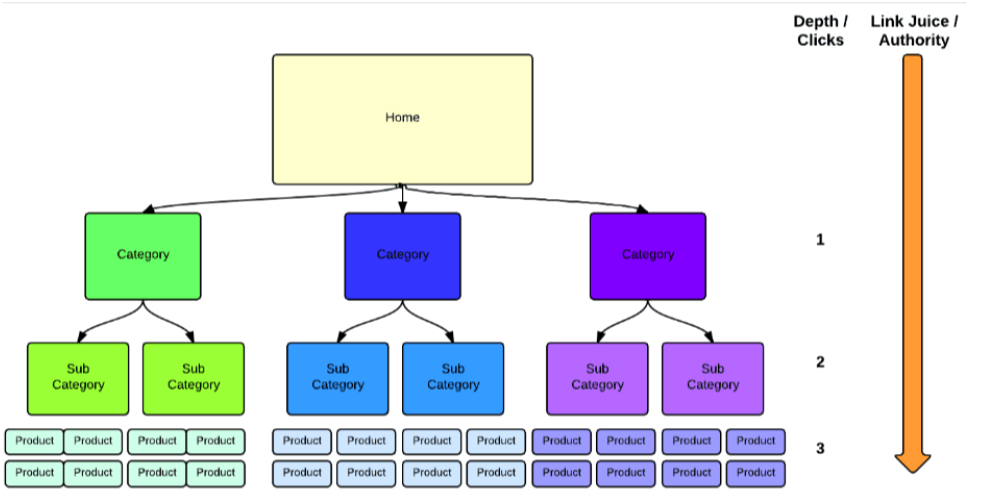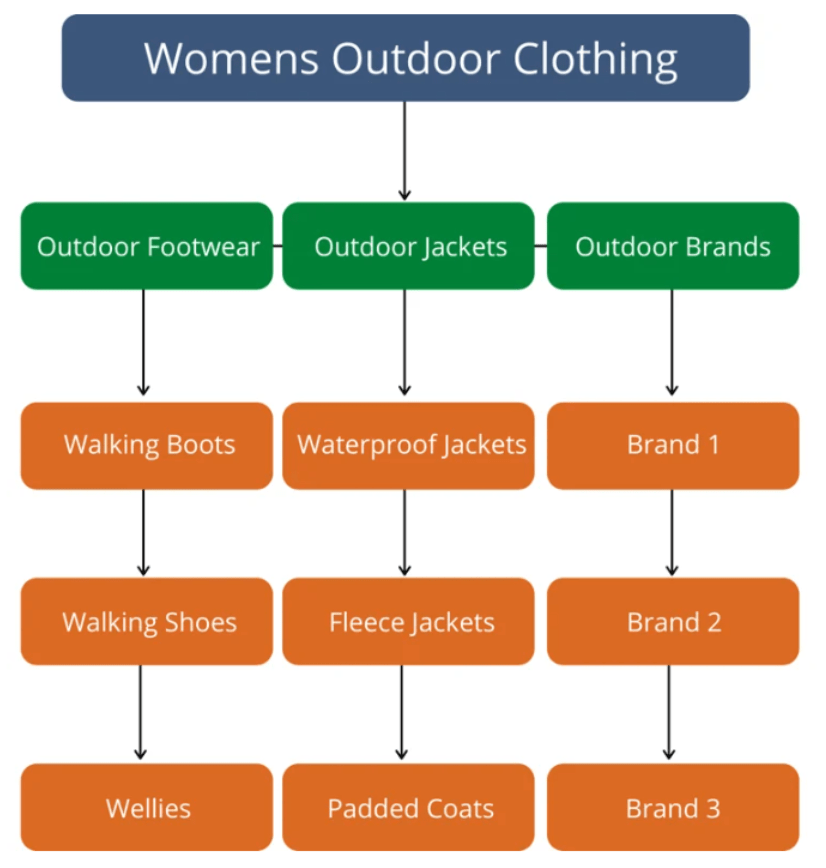5 Surefire Ways to Improve E-Commerce Category Pages for SEO

5 Surefire Ways to Improve E-Commerce Category Pages for SEO
Explore how SEO-optimized category pages can enhance your search rankings. Packed with actionable insights, this article empowers e-commerce businesses to amplify their online presence and drive organic traffic effectively.
Category pages serve as the connection between your homepage and individual product pages. They play a crucial role in the sales process, facilitating easier navigation for customers and impacting your website's search engine rankings.
These pages are strategically designed with specific keywords to organize content and help search engine bots understand the focus of your E-commerce site. By optimizing category pages effectively, you can attract more visitors to your site and enhance your customers' overall shopping journey.
Let’s dive into effective strategies for enhancing the SEO for category pages.
Understanding the Importance of E-Commerce Category Pages
Research from a study conducted on over 30 leading e-commerce websites in the United States reveals a significant finding:
Category pages drive a staggering 413% more estimated traffic than product pages.
That's huge!
But why is category page optimization so powerful?
It's because category pages are the glue that holds everything together for users and search engines.
For users, category pages provide a structured way to navigate and locate desired products easily. Meanwhile, tell search engines what your site is all about —by indexing and ranking content effectively.
How do they do it?
This is primarily because category pages help search engines comprehend the interrelation between various pieces of content within the website. Moreover, they boost the ranking of individual content pieces through strategic internal linking.
“After the homepage, category pages are the second prime spot to drive the site's visibility and attract more visitors.”
-Vineet Gupta, Founder of SEO agency 5MinutesSEO & 2xSaS
The diagram below illustrates that category pages typically possess higher authority and "link juice" due to their placement at the top of the hierarchy.
However, to capitalize on this advantage and witness tangible improvements, you need to roll up your sleeves and do some SEO work to optimize these pages for better rankings and increased traffic.
5 Ways to Enhance E-commerce Category Pages
Here are the top five SEO practices for e-commerce category pages worth investing in and implementing.
- Optimize product categorization
- Refine meta descriptions
- Integrate relevant keywords
- Enhance user experience
- Craft compelling and meaningful content
1. Optimize Product Categorization
When structuring your website for better search engine optimization (SEO), remember the golden rule: Make sure users can find what they need within three clicks from the homepage. If it takes more clicks, they might get frustrated and leave.
For e-commerce sites, think of your website structure as a pyramid. At the top is your homepage, and beneath that are a few levels of categories or sections, leading eventually to the individual product pages.
The key is to keep your navigation simple and intuitive. Use clear labels in your menu, and make sure internal links guide users logically through your site. It's also helpful to offer filtering options so visitors can easily narrow down their search.
No matter where someone lands on your site, they should have no trouble finding the products they're interested in.
Additional Reading: How To Adapt Business Strategies For Prolonged Sales Cycles
2. Refine Meta Descriptions
Meta descriptions are brief snippets that concisely summarize your webpage's content.
While the description of a category page doesn't directly impact its on-page SEO, it plays a crucial role in increasing the click-through rate (CTR) once your page ranks on the first page of search results.
What you write in the meta description might be displayed in search results, so it's important to craft it carefully.
Aim to summarize your products and offerings in your category descriptions and highlight any special deals or features, such as free shipping or returns, to attract users to click on your link.

Some industry experts suggested best practices for meta-description optimization:
- Keep it concise, around 155 characters or less.
- Incorporate your target search term into your H1 tag and opening description.
- Regularly update your meta descriptions to keep them fresh and engaging.
Following these practices will help you create compelling meta descriptions that entice users to visit your category pages. XXX
3. Integrate Relevant Keywords
Optimizing your e-commerce category pages with targeted keyword research can significantly enhance their visibility and draw in relevant traffic.
Long-tail keywords, characterized by their specificity, offer tremendous opportunities.
For instance, in the context of bed collections, targeting terms like "bunk beds with trundle and stairs" alongside broader keywords like "bunk bed" can be incredibly valuable.

Focusing on long-tail keywords allows you to cater to niche markets, attract more qualified leads, and ultimately increase your chances of conversions.
PRO TIPS:
- Ensure your category URL is SEO-friendly.
- Incorporate your target search term into your H1 tag and opening description.
- Leverage Google's autocomplete feature to discover synonyms and related keywords for your target term. Address these queries within your keyword integration for E-commerce copy to enhance relevance.
Additional Reading: 6 New SEO Metrics for an Evolving Search Landscape
4. Enhance User Experience
Improving your e-commerce website's user experience (UX) is crucial for retaining customers and boosting conversions.
Toptal reports that 88% of users are unlikely to revisit a site with poor UX, while PWC found that 32% of users may even abandon a previously loved brand after one bad experience.
Conversely, good user experience optimization can skyrocket conversion rates significantly.
Here are some practical tips to enhance your e-commerce UX:
- Try Content Delivery Network (CDN): CDNs make your content load faster by connecting users to servers closer to their location.
- Optimize Visuals: Use tools or plugins to compress images, reducing load times without compromising quality.
- Create Scannable Subheadings: Make subheadings descriptive and easy to skim, helping visitors quickly understand the page's content.
- Implement Filters Effectively: Dedicate specific sections for filters and ensure they are user-friendly with options like checkboxes. Provide various sorting choices for seamless navigation and a well-structured layout.
What Tools To Use:
Google's Core Web Vitals (CWV) gauge a webpage's performance in three key areas:
- Largest Contentful Paint (LCP): Measures loading performance.
- First Input Delay (FID): Evaluates interactivity.
- Cumulative Layout Shift (CLS): Assesses visual stability.
You can monitor your CWV scores using tools like Google's PageSpeed Insights.
Relevant Read: Top User Experience (UX) Agencies for Retail Companies
5. Craft Compelling and Meaningful SEO Content
When adding keywords to your SEO content, be careful not to stuff your content with keywords. Your category pages should offer more than just a collection of keywords.
What you should avoid:
Category page content needs more than just a list of product names and descriptions, especially if you're not a well-known brand. For example, if you're starting a print-on-demand business, your category pages could provide insightful introductions to your unique designs, sharing the story behind each collection.
But remember that overloading your page with content above the product grid can harm conversion rates by pushing product listings further down, possibly even below the fold.
Many SEO professionals have tried placing content below the product grid to address this issue. However, in reality, this content often goes unnoticed and unread.
For instance, look at the content shown below. It’s nothing more than generic "SEO content," which adds no real value to the user experience.

Content placed this far down the page will not likely sway a user's purchase decision. It's evident that it's solely crafted for search engines, lacking any real appeal to potential buyers.
In contrast, consider the "Advice and Inspiration" content found at the bottom of the Headphones category on other websites.
This content is clearly tailored to the user experience, offering valuable advice and inspiration to enhance the user's journey on the site.

By focusing on creating meaningful and user-centric content, you can significantly improve both your SEO efforts and user engagement on your category pages.
What you should do instead:
Your primary audience is your shoppers, not search engines.
Center your content on providing value by answering questions, educating about products, and guiding toward the next step—whether exploring further or clicking through to product pages.
Some key guidelines to keep in mind:
- Content Above the Product Grid (Top of the Page):
- Length: Aim for around 75–100 words.
- Objective: Use this space to help shoppers refine their choices, highlight sales or special items, showcase top brands, and provide essential information in a concise format.
- Content Below the Product Grid (bottom of the page):
- Length: No set minimum length, but ensure it's valuable for your readers.
- Objective: Use this section to offer additional resources for shoppers to conduct further research without leaving your site. Provide links to educational or interactive content that will guide them along the sales funnel
Common SEO Mistakes to Avoid in E-Commerce Category Pages
Avoiding these common SEO mistakes can significantly improve your e-commerce category pages' performance.
- Not performing regular site audits
- Not optimizing URL slugs
- Don’t over-optimize your e-commerce pages
- Not interlinking in category pages
- Forgetting to optimize for duplication
Not Performing Regular Site Audits
Neglecting regular site audits is a common mistake in e-commerce SEO strategies. By conducting routine audits that specifically examine your category pages, you can:
- Identify and address 404 or 302 pages.
- Update outdated structured data.
- Refresh on-page category content.
Be proactive in updating your category pages.
For instance, if a satisfied customer shared positive feedback about your products, consider incorporating their video testimonial into the category page to enhance credibility and engagement.
Not Optimizing URL Slugs
An often overlooked aspect of optimizing category pages for organic traffic is the default URL structure many e-commerce platforms generate. Instead of relying on random strings of characters, it's crucial to customize the URL with the category's target keyword.
For instance:
- Amazon includes keywords in their category page URLs, such as: https://amazon.com/c/nike-running-shoes
- Contrastingly, a default e-commerce setup might generate something like: ecommercestore.com/c/795324/
Moreover, it's essential to go beyond merely listing products within the category and create comprehensive content for these pages. Adhering to basic on-page SEO guidelines is key to improving the ranking potential of these pages.
Don’t Over-Optimize Your E-Commerce Pages
Avoid excessive keyword optimization and prioritize enhancing the user experience by treating your category pages as informative buyers' guides.
While it's essential to include primary and secondary keywords, refrain from keyword stuffing as it diminishes the credibility of your page.
Google Search Advocate John Mueller highlighted this issue, stating:
“Another thing I sometimes see, especially with e-commerce sites, is that people go to extremes on category pages by repeating keywords excessively.
Overusing keywords on category pages can trigger suspicion from search algorithms, leading to decreased trustworthiness.”
Remember, category page SEO goes beyond keywords. Providing an excellent user experience boosts visitor engagement, increases dwell time, and reduces bounce rates. All the factors Google takes into account when ranking pages.
Not Interlinking in Category Pages
Failing to centralize your products around category pages can diminish their relevance.
Google's John Mueller emphasizes the importance of internal linking, stating that linking to category pages from product pages helps Google recognize their significance during website crawling.
This approach mirrors the strategy used in SEO blog content, where topic pillars enhance internal linking and topical authority.
Google advises making category pages easily accessible from product pages. While navigation menus are effective, incorporating internal links within product descriptions further reinforces this connection.
Forgetting to Optimize for Duplication
Faceted navigation pages can create additional URLs with filtered content, impacting your SEO efforts if not managed properly.
URLs generated from filters can lead to duplicate content issues, index bloat, and wasted crawl budget.
Since the content on these pages is often similar, managing them effectively is essential to prevent Google from indexing them unnecessarily.

Consider these options:
- Canonicalize parameter URLs (those generated by filters/facets) to the main category page.
- Completely noindex parameter URLs. (Note: Avoid using canonical and noindex tactics together. Choose one approach.)
- Utilize robots.txt with a disallow rule to manage access to these pages.
By carefully managing faceted navigation and duplicate content, you can maintain a cleaner, more efficient site structure that enhances your overall SEO performance.
Mastering the Perfect E-Commerce Category Pages For SEO
The effectiveness of your e-commerce category pages in presenting and selling products to customers hinges on how well they're organized and structured.
During the strategy phase of the e-commerce website SEO plan, take ample time to comprehend your target audience, evaluate competitors, and establish realistic goals.
Remember, e-commerce category optimization should be viewed as an ongoing process rather than a one-time task. Continuous analysis and adjustments are necessary over time to ensure sustained success.
Hire a trusted SEO agency on The Manifest



